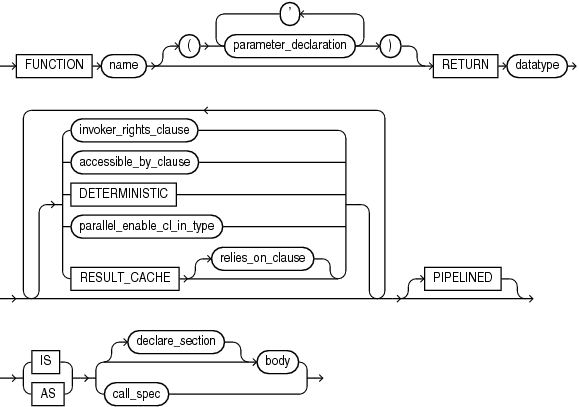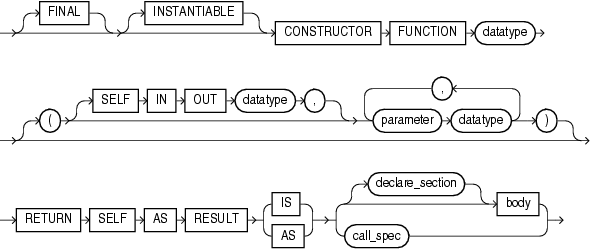CREATE TYPE BODY Statement
The CREATE TYPE BODY defines or implements the member methods defined in the type specification that was created with the "CREATE TYPE Statement".
For each method specified in a type specification for which you did not specify the call_spec, you must specify a corresponding method body in the type body.
Note:
If you create a SQLJ object type, then specify it as a Java class.Every member declaration in the CREATE TYPE specification for an ADT must have a corresponding construct in the CREATE TYPE or CREATE TYPE BODY statement.
To create or replace a type body in your schema, you must have the CREATE TYPE or the CREATE ANY TYPE system privilege. To create a type in another user's schema, you must have the CREATE ANY TYPE system privilege. To replace a type in another user's schema, you must have the DROP ANY TYPE system privilege.

Description of the illustration create_type_body.gif

Description of the illustration plsql_type_body_source.gif
See:

Description of the illustration subprog_decl_in_type.gif

Description of the illustration proc_decl_in_type.gif
See:

Description of the illustration func_decl_in_type.gif
See:
parallel_enable_cl_in_type ::=

Description of the illustration parallel_enable_cl_in_type.gif

Description of the illustration streaming_cl_in_type.gif

Description of the illustration constructor_declaration.gif
See "call_spec ::=".
map_order_func_declaration ::=

Description of the illustration map_order_func_declaration.gif
Re-creates the type body if it exists, and recompiles it.
Users who were granted privileges on the type body before it was redefined can still access the type body without being regranted the privileges.
You can use this clause to add member subprogram definitions to specifications added with the ALTER TYPE ... REPLACE statement.
[ EDITIONABLE | NONEDITIONABLE ]
If you do not specify this property, then the type body inherits EDITIONABLE or NONEDITIONABLE from the type specification. If you do specify this property, then it must match that of the type specification.
Name of the schema containing the type body. Default: your schema.
Name of an ADT.
The type of function or procedure subprogram associated with the type specification.
You must define a corresponding method name and optional parameter list in the type specification for each procedure or function declaration. For functions, you also must specify a return type.
proc_decl_in_type, func_decl_in_type
A procedure or function subprogram declaration.
Indicates that the function can run from a parallel execution server of a parallel query operation. The function must not use session state, such as package variables, because those variables are not necessarily shared among the parallel execution servers. The parallel_enable_cl_in_type can appear only once in the function.
Use the optional PARTITION argument BY clause only with a function that has a REF CURSOR data type. This clause lets you define the partitioning of the inputs to the function from the REF CURSOR argument. Partitioning the inputs to the function affects the way the query is parallelized when the function is used as a table function in the FROM clause of the query.
ANY Indicates that the data can be partitioned randomly among the parallel execution servers
Note:
You can partition weak cursor variable arguments to table functions only withANY, not with RANGE, HASH, or VALUE.RANGE or HASH Partitions data into specified columns that are returned by the REF CURSOR argument of the function.
The optional streaming_cl_in_type lets you order or cluster the parallel processing.
ORDER BY or CLUSTER BY indicates that the rows on a parallel execution server must be locally ordered and have the same key values as specified by the column list.
expr identifies the REF CURSOR parameter name of the table function on which partitioning was specified, and on whose columns you are specifying ordering or clustering for each slave in a parallel query execution.
VALUE Specifies direct-key partitioning, which is intended for table functions used when executing MapReduce workloads. The column must be of data type NUMBER. VALUE distributes row processing uniformly over the available reducers.
If the column has more reducer numbers than there are available reducers, then PL/SQL uses a modulus operation to map the reducer numbers in the column into the correct range.
When calculating the number of the reducer to process the corresponding row, PL/SQL treats a negative value as zero and rounds a positive fractional value to the nearest integer.
See Also:
-
Oracle Database In-Database MapReduce User's Guide for more information about using direct-key partitioning in table functions when executing MapReduce workloads
-
Oracle Database Data Cartridge Developer's Guide for information about using parallel table functions
A user-defined constructor subprogram declaration. The RETURN clause of a constructor function must be RETURN SELF AS RESULT. This setting indicates that the most specific type of the value returned by the constructor function is the most specific type of the SELF argument that was passed in to the constructor function.
See Also:
-
"CREATE TYPE Statement" for a list of restrictions on user-defined functions
-
"Overloaded Subprograms" for information about overloading subprogram names
-
Oracle Database Object-Relational Developer's Guide for information about and examples of user-defined constructors
Declares items that are local to the procedure or function.
Procedure or function statements.
See "call_spec" and "EXTERNAL".
You can declare either one MAP method or one ORDER method, regardless of how many MEMBER or STATIC methods you declare. If you declare either a MAP or ORDER method, then you can compare object instances in SQL.
If you do not declare either method, then you can compare object instances only for equality or inequality. Instances of the same type definition are equal only if each pair of their corresponding attributes is equal.
Declares or implements a MAP member function that returns the relative position of a given instance in the ordering of all instances of the object. A MAP method is called implicitly and specifies an ordering of object instances by mapping them to values of a predefined scalar type. PL/SQL uses the ordering to evaluate Boolean expressions and to perform comparisons.
If the argument to the MAP method is null, then the MAP method returns null and the method is not invoked.
An type body can contain only one MAP method, which must be a function. The MAP function can have no arguments other than the implicit SELF argument.
Specifies an ORDER member function that takes an instance of an object as an explicit argument and the implicit SELF argument and returns either a negative integer, zero, or a positive integer, indicating that the implicit SELF argument is less than, equal to, or greater than the explicit argument, respectively.
If either argument to the ORDER method is null, then the ORDER method returns null and the method is not invoked.
When instances of the same ADT definition are compared in an ORDER BY clause, the database invokes the ORDER MEMBER func_decl_in_type.
An object specification can contain only one ORDER method, which must be a function having the return type NUMBER.
A function subprogram declaration. See "CREATE PROCEDURE Statement" and "CREATE FUNCTION Statement" for the full syntax with all possible clauses.
Deprecated way of declaring a C method, supported only for backward compatibility. Oracle recommends that you use the LANGUAGE C syntax.
Several examples of creating type bodies appear in the Examples section of "CREATE TYPE Statement". For an example of re-creating a type body, see "Adding a Member Function: Example".